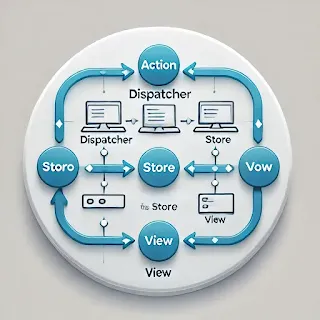Flux Architecture is a pattern for managing unidirectional data flow in React applications. It was introduced by Facebook to handle complex state management efficiently. Flux emphasizes a clear separation of concerns and predictable state changes, making it easier to manage the application state as the app grows in complexity.
Key Concepts of Flux Architecture
- Action:
- Actions are payloads of
information that send data from your application to the store. They are
triggered by user interactions or other events (like an API call).
- Actions are simple
JavaScript objects with two properties: type (describing the action) and payload (containing relevant
data).
Example:
{
type: 'ADD_ITEM',
payload: { id:
1, name: 'Item 1' }
}
- Dispatcher:
- The dispatcher is a central
hub that manages all actions and coordinates updates to the stores.
- It acts as a mechanism to
dispatch the action to the appropriate store(s) by registering callbacks.
In essence, when an action is created, it goes
through the dispatcher to the stores.
- Store:
- Stores hold the state of
the application. Each store is responsible for a particular domain of the
app (e.g., a UserStore, ProductStore).
- When a store receives an
action, it updates its state accordingly and then notifies the views
(React components) of the change.
- Stores have no direct
communication with each other; they only respond to the dispatcher.
- View (React Component):
- Views are React components
that listen to changes in the store and re-render when the state changes.
- They fetch the current
state from the store, which drives the UI.
- User interactions in the
view trigger actions, creating a loop.
Flux Unidirectional Data Flow
The key
principle in Flux is unidirectional data flow, which ensures data moves
in a single direction, simplifying state management:
- Action: User interaction or a
system event triggers an action.
- Dispatcher: The dispatcher forwards
the action to the store.
- Store: The store processes the
action, updates its state, and emits a change event.
- View: The view re-renders in
response to the state change and the cycle continues.
Flux Data Flow Overview
- A user interacts with the View: This can be a button click
or form submission.
- An Action is created: The View creates an Action
and sends it to the Dispatcher.
- Dispatcher sends the Action
to the Store:
The Dispatcher passes the Action to all registered Stores.
- Store updates and emits a
change:
The Store processes the action, updates its internal state, and emits a
change event.
View re-renders based on updated state: The View listens to the Store's change event and fetches the updated state to reflect it in the UI.

No comments:
Post a Comment